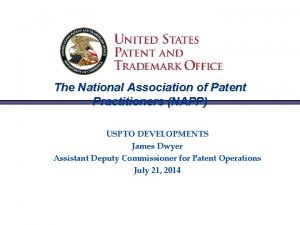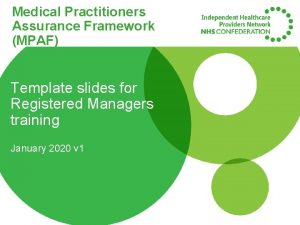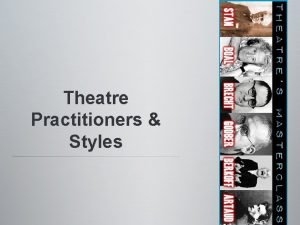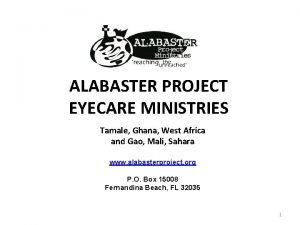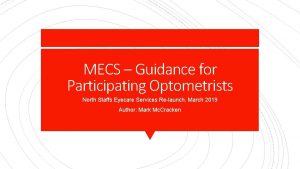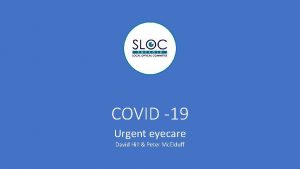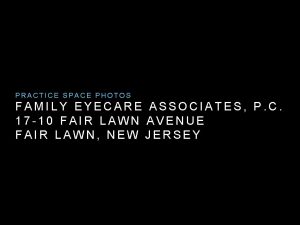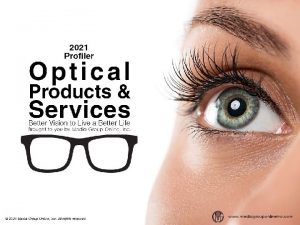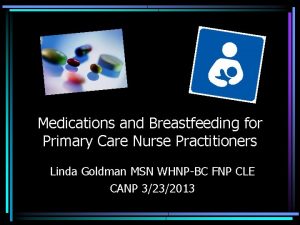Eyecare Review For Primary Care Practitioners Primary Care












































































































- Slides: 108

Eyecare Review— For Primary Care Practitioners

Primary Care Practitioners n n See variety of eye problems Discuss treatment options Facilitate referrals Positioned to explain optometry's role as primary eye care providers 2

Outline n n n n Anatomy Optics Turned Eyes Lazy Eye External Conditions Internal Conditions Diabetic Retinopathy 3

ANATOMY 4

Basic Anatomy Sclera Choroid Retina Cornea Fovea Pupil Lens Iris Ciliary Body Optic Nerve 5

Lids n n Lashes—protection from foreign material Glands—lubricate anterior surface o Meibomian glands o Glands of Zeis o Glands of Moll 6

Conjunctiva n Thin, transparent, vascular layer lining o Backs of eyelids o Fornices o Anterior sclera 7

Sclera n n n Tough outer shell Composed of collagen bundles Protects from penetration 8

Cornea n n Composed of regularly oriented collagen fibers 5 layers 9

Anterior Chamber n n Space between cornea and iris Filled with aqueous humor produced by ciliary body 10

Iris n n Iris gives eye color 2 muscles: o Dilator—opens o Sphincter—constricts 11

Pupil n n Allows light to enter Enables view to back of eye and eye health evaluation 12

Lens n n n Located behind iris Focuses light on retina Allows for accommodation Normally transparent Where cataracts form 13

Ciliary Body n Primary functions o Pulls on lens for accommodation o Epithelium secretes aqueous fluid that fills anterior chamber 14

Red Reflex n n Light reflection off retina Useful for assessing media clarity Affected by any opacity of cornea, lens, vitreous White reflex = leukocoria Refer immediately! 15

Vitreous Humor n n Gel-like fluid that fills back cavity Serves as support structure for blood vessels while eye formed—before birth After birth, just ‘hangs out’ in there Where floaters are located 16

Fundus n n Interior surface of eye Includes o Optic nerve o Retina o Vasculature 17

Optic Nerve Head n n Collection of nerve fibers and blood vessels from retina Transfers info to brain’s visual cortex Slightly yellow-pink when healthy White ‘full moon’ appearance can mean trouble! 18

Optic Nerve Head n n n Cup is natural depression in center of nerve Cup size varies between people Very large cup, or change in appearance over time, can indicate glaucoma Physiologic Cup Optic Disc Optic Nerve 19

Macula n n n Dense collection of cone photoreceptors Fine detail and color vision Macular degeneration affects this area 20

Retinal Vessels n n n Include arteries and veins Only place in body where you can directly visualize blood vessels Excellent indicators of systemic diseases o o HTN Diabetes High cholesterol Carotid disease 21

Peripheral Retina n n Can only be evaluated with dilated pupil Important to evaluate periodically to fully assess eye health 22

OPTICS 23

Optics Review n n Myopia Hyperopia Astigmatism Presbyopia 24

Myopia n n Nearsightedness See well up close but blurry in distance Eye is too long Light focuses in front of retina 25

Hyperopia n n Farsightedness See well in distance Eye is too short Focus point is behind retina 26

Hyperopia n n n Blurry image on retina Lens focuses to compensate Hyperopes often asymptomatic much their of lives Can cause headaches or eyestrain with extended reading These problems can get worse after age 40 27

Astigmatism n n n Surface of cornea is irregular or misshapen Light focuses at various points causing distorted vision Often combined with nearsightedness and farsightedness 28

Presbyopia n n Normal, age-related change Near vision becomes difficult Mid-40 s lens becomes less elastic and loses ability to change focus Time for bifocals… 29

MISALIGNED EYES 30

Turned Eyes - Strabismus n Eye misalignment o One or both turn in, out, up or down n n Caused by muscle imbalance 3 Kinds of Strabismus o Esotropia o Exotropia o Hypertropia 31

1. Esotropia n Eye turns in towards nose 32

3 Types of Esotropia n Infantile (congenital) o Develops in first 3 months of life o Surgery usually recommended— along with vision therapy and glasses n Accommodative o Usually noted around age 2 o Child typically farsighted o Focusing to make images clear can cause eyes to turn inward o Treated with glasses but vision therapy may also be needed 33

3 Types of Esotropia n Partially Accommodative o Combination of n n accommodative dysfunction and muscle imbalance o Glasses and vision therapy won’t completely correct eye turn o Surgery may be required for best binocularity 34

If you see Esotropia n Refer to pediatric optometrist or ophthalmologist n Sooner the better for best chance of good vision 35

2. Exotropia n n Eye turns outward Congenital—present at birth Surgery usually needed to re-align Many exotropias are intermittent o May occur when patient is tired or not paying attention o Concentration can force eyes to re-align o Vision therapy and/or glasses can help 36

2. Exotropia n When intermittent o Brain sometimes receives info from both eyes (binocular) o Less chance of amblyopia o However, important to be seen by eyecare provider when deviation noted 37

3. Hypertropia n n n One eye vertically misaligned Usually from paresis of an extra-ocular muscle Typically much more subtle for patient to describe and provider to diagnose 38

2 Types n Congenital o Most common type o Patients can compensate for years by tilting head o Can be discovered by looking at childhood photos 39

2 Types n Acquired o Trauma— Extra-ocular muscle ‘trapped’ by orbital fracture o Vascular infarct— Systemic diseases that affect blood supply to nerves can cause temporary nerve palsy n n Diabetes and HTN most common Palsies tend to resolve over weeks or months o Neurological— In rare cases a tumor or aneurysm can cause symptoms 40

LAZY EYE 41

Lazy Eye - Amblyopia n n Decreased vision uncorrectable by glasses or contacts—not due to eye disease For some reason, brain doesn’t fully acknowledge images seen 42

Lazy Eye - Amblyopia n 3 Types of Amblyopia o Strabismic o Anisometropic o Stimulus deprivation 43

1. Strabismic Amblyopia n n n One eye deviates from other and sends conflicting info to brain Brain doesn’t like to see double— so “turns off” info from deviated eye Results in under developed visual cortex for that eye Can usually be reversed or decreased if treated during first 9 years Need to visit eyecare provider ASAP to determine cause 44

Treatment n If caught early, treatment can teach brain how to see better o Vision therapy/patching o Glasses o Surgical re-alignment n Early vision screenings are critical! 45

2. Anisometropic Amblyopia n n Anisometropia—significant difference in Rx between eyes Commonly one eye more farsighted Farsighted eye works hard to see clearly—and sometimes gives up Brain relies on info from other eye 46

2. Anisometropic Amblyopia n n n If not caught, one eye won’t learn to see as well as other Vision therapy and glasses are both beneficial Sooner the better 47

3. Deprivational Amblyopia n Any opacity in visual pathway can be devastating to developing visual system o Congenital cataracts o Corneal opacities o Ptosis (droopy eyelid) o Other media opacities 48

EXTERNAL CONDITIONS 49

Common External Ocular Conditions n n n Blepharitis Hordeolum—stye Preseptal cellulitis Orbital cellulitis Pterygium Corneal ulcer n Conjunctivitis o o o Viral “pink eye” Adenovirus Bacterial Allergic Hyperacute Chlamydial 50

Blepharitis n n Inflammation of eyelids (anterior or posterior) Symptoms o o o Itching Burning Crusting Dry eye sensation Foreign body sensation 51

Blepharitis n Signs o Crusts on lid margins o Thickened, reddened eyelids o Plugged or inspisated meibomian glands along eyelid n Treatment o Warm compresses, 10 minutes 1 -2 x/day o Lid scrubs with diluted baby shampoo o Artificial tears o Erythromycin ointment at night 52

Hordeolum (stye) n n n Abscessed meibomian gland Raised, tender nodule Often gets larger over days to a week 53

Hordeolum n Signs o Raised nodule protruding out from or under lid o Red, swollen lid o Capped glands at site of infection n Treatment o Warm compresses, BID-TID for 10 mins o Topical meds don’t penetrate abscess o Oral antibiotics if no response to traditional treatment 54

Preseptal Cellulitis n n Bacterial infection of eyelid anterior to orbital septum Can arise from o concurrent sinus infection o penetrating lid trauma o dental infection o hordeolum o insect bite 55

Preseptal Cellulitis n Signs o Painful, swollen lid extending past orbital rim o May be unable to open eye o No decreased vision, restricted ocular motility or proptosis o White conjunctiva n Treatment o Amoxicillin (augmentin) 500 mg PO TID o Treat infection quickly to minimize risk of orbital cellulitis 56

Orbital Cellulitis n n n Serious infection of soft tissues behind orbital septum Can be life-threatening Causes o Sinus infection o Extension of preseptal cellulitis o Dental infection o Penetrating lid injury o After ocular surgery 57

Orbital Cellulitis n Signs o Tender, warm periorbital lid edema o Proptosis o Painful ophthalmoplegia o Decreased vision o Severe malaise, fever and pain n Treatment o Medical emergency o Hospitalization with IV antibiotics o Consider orbit/head CT to look for abscess o Consult pediatrician or infectious disease specialist 58

Preseptal vs. Orbital Cellulitis n Preseptal o Painful, swollen lid extending beyond orbital rim o Normal vision o Full EOMs o White conjunctiva o No proptosis o No fever n Orbital o Painful, swollen lid that stops at orbital rim o Decreased vision o Restricted ocular motilities o Proptosis o Fever/malaise 59

Pterygium n n Triangular-shaped growth of conjunctival tissue onto cornea Causes o UV exposure o Dryness o Irritants n n Smoke Dust 60

Pterygium n Signs o o Dry eye Irritation Redness Blurred vision n Management and Treatment o UV tint on glasses o Avoid irritating environments o Artificial tears o Topical vasoconstrictor or mild steroid o Surgery 61

Corneal Ulcer n Infection of cornea o Bacterial o Fungal o Acanthamoeba n Causes o SCL wearer o Trauma o Compromised cornea from pre-existing condition 62

Corneal Ulcer n Signs o o o Pain Photophobia Blurred vision Discharge Hypopyon n Treatment: o Start immediately n n Fortified antibiotics Fluoroquinolones o Culture may not be necessary if ulcer is small o Must be monitored daily! 63

Conjunctivitis (red eye) n Various Causes 1. Viral/Adenovirus 2. Bacterial 3. Allergic 4. Chlamydial 5. Herpetic 6. Toxic 64

Conjunctivitis n Signs o o o Irritation Burning/stinging Watering Photophobia Pain or foreign body sensation o Itching n Discharge o o Watery Mucoid Mucopurulent Purulent 65

1. Viral Conjunctivitis (pink eye) n n Most viral infections are fairly mild and self-limiting Signs & Symptoms o Watering o Redness o Photophobia o Discomfort/foreign body sensation o Palpable preauricular node 66

1. Viral Conjunctivitis n n Patients often have recent history of URI Treat symptoms o Cool compresses o Artificial tears o Topical vasoconstrictors or mild antiinflammatory n n Frequent handwashing Usually runs course in 1 -3 weeks 67

2. Adenoviral Conjunctivitis n n Highly contagious Most common types o Pharyngoconjunctival fever (PCF)— can be caused by adenovirus types 3, 4 & 7 o Epidemic keratoconjunctivitis (EKC)— caused most commonly by adenovirus types 8 & 19 68

2. Adenoviral Conjunctivitis n Signs o Watering o Conjunctival follicles o Subconjunctival hemorrhages o Chemosis o Pseudomembranes o Lymphadenopathy o Keratitis 69

3. Bacterial Conjunctivitis n n n Common, especially in children Usually self-limiting Signs/symptoms o Acute redness o Burning/grittiness o Mucopurulent discharge o Lids stuck shut in morning 70

3. Bacterial Conjunctivitis n n Common organisms: S. aureus, S. epidermidis, S. pneumonia, H. influenza (esp. peds) Usually self-limiting But important to use broad-spectrum antibiotic until discharge cleared (5 -7 days) Antibiotics o Tobramycin o Polytrim—polymyxin + trimethoprim o Fluoroquinolones like Ocuflox or Ciloxan 71

5. Hyperacute Conjunctivitis n Cause o Sexually transmitted o Neisseria gonorrhoeae n Signs o Swollen, tender lids o Copious purulent discharge o Significant conjunctival redness and swelling o Lymphadenopathy 72

5. Hyperacute Conjunctivitis n Treatment o Lavage o Take scrapings for culture and sensitivity testing o Patients usually hospitalized and started on IM Ceftriaxone o Topical antibiotics not effective 73

6. Chlamydial Conjunctivitis n Cause o Sexually transmitted ocular infection n Signs o Patients typically have mild but persistent follicular conjunctivitis non respondent to topical antibiotics o Any conjunctivitis lasting longer than 3 weeks despite therapy should be suspect 74

6. Chlamydial Conjunctivitis n Patients can have concomitant genital infection (could be asymptomatic) o Refer for work-up if necessary n Treatment o Oral—Azithromycin 1 g, doxycycline 100 mg bid x 7 days, erythromycin 500 mg qid x 7 days. Also need to tx partners! o Topical—erythromycin, tetracycline, or sulfacetamide ung bid-tid x 2 -3 weeks 75

4. Allergic Conjunctivitis n n Can be seasonal or acute Signs/symptoms o o o Itching is hallmark Conjunctival redness Chemosis Lid edema Thin, watery discharge No palpable preauricular nodes 76

4. Allergic Conjunctivitis n Treatment o Eliminate offending agent o If mild n n Cool compresses Artificial tears/vasoconstrictors o If moderate or severe n n Topical antihistamine/mast-cell stabilizer (ie. Patanol) Topical NSAID Topical steroid Oral antihistamine 77

INTERNAL CONDITIONS 78

Internal Ocular Conditions n n Glaucoma Cataracts Macular Degeneration Retinal detachment 79

Glaucoma n n n Progressive loss of Nerve fiber layer at ONH (increased cupping) Can lead to peripheral visual field loss Sometimes caused by elevated intraocular pressure 80

Glaucoma n n Pathophysiology of progression not well understood Increased IOP o Damages nerves as they leave eye, causing cell death o Reduces blood supply to ONH, indirectly destroying cells by starving them of oxygen and nutrients n Abnormal levels of neurotransmitter (glutamate) cause cells to die off 81

Glaucoma n Monitoring o o IOP ONH appearance Visual field testing Newer methods include n n n HRT (Heidelberg Retinal Tomograph II) GDx Nerve Fiber Analyzer Genetic testing 82

Glaucoma n n IOP reduction is mainstay of treatment Decrease aqueous production o B-blockers o Alpha-agonists o Carbonic anhydrase inhibitors n Increase uveoscleral outflow o prostaglandin analogs 83

Cataract n n Clouding of natural lens Patients experience o Blurred/dim vision o Glare, especially at night o Halos around lights o Doubling or ghost images of objects 84

Etiology n n Everyone develops them if they live long enough! Types of cataracts o Age-related—senile o Trauma—blunt or perforating injury o Systemic conditions—diabetes o Medications—steroids 85

Main Types n Age-related o Nuclear sclerotic o Cortical spokes o Posterior subcapsular o Mature cataract 86

Treatment n n Surgery When loss of vision interferes with daily activities o Driving o Reading o Hobbies 87

Outpatient Surgery n 5 -10 minutes with skilled surgeon o Incision through cornea or sclera under upper lid o Circular tear in anterior capsule o Lens broken up with ultra sound instrument o Fragments suctioned out o Lens implant inserted 88

Secondary Cataract n n Cloudiness forms on posterior capsule after cataract surgery 30 -50% of patients YAG laser used to create opening Vision quickly restored 89

Macular Degeneration n #1 cause of blindness in Americans over age 65 90

Pathophysiology n n Causes not well understood Theorized link to o UV light exposure o subsequent release of free radicals o oxidation within retinal tissues n Another theory—areas of decreased vascular perfusion in retina, lead to cell death 91

Two Types n Dry (atrophic) o 90% of those diagnosed n Wet (exudative) o 10% of those diagnosed o But accounts for 90% of blindness caused by disease 92

Symptoms n n None Blurred vision Metamorphopsia— straight lines appear wavy or distorted Scotomas—missing areas in vision 93

Dry Form n n Slow, progressive loss of central vision Breakdown of underlying retinal tissues, resulting in mottling or clumping of normal pigment Drusen begin to accumulate Geographic atrophy can also occur 94

Wet Form n n n Can quickly degrade central vision Break in underlying tissues allows new blood vessels or fluid to come through New blood vessels are weak so frequently break and bleed 95

Treatment for Dry Form n n n Regular eye exams Careful discussion regarding family history Education UV protection Antioxidants o AREDS o Preser. Vision n Stop smoking 96

Treatment for Wet Form n n n Refer to retinal specialist Photocoagulation Photo-dynamic therapy (PDT) Submacular surgery Macular translocation Anti-angiogenic drug therapy 97

Retinal Detachment n Several types o Rhegmatogenous— caused by break in retina o Exudative—caused by fluid accumulation beneath retina o Tractional—proliferative fibrovascular vitreal strands 98

Signs & Symptoms n n n Flashing lights in peripheral vision New floaters—black spots or ‘cobwebs’ Peripheral scotoma—dark shadow or “curtain” blocking vision 99

Emergency n n Patients with these symptoms must see eyecare provider immediately Additional risk factors o Highly nearsighted o Diabetic o Recent trauma/injury 100

Treatment n n Laser photocoagulation or cryotherapy Pneumatic retinopexy— gas bubble to tamponade retina back into place Scleral buckle Silicone oil 101

DIABETIC RETINOPATHY 102

Diabetic Retinopathy n n Diabetes affects retinal microvasculature One of leading causes of blindness among ages 20 -64 103

Progression n Over time, elevated and fluctuating blood sugar damages vessel walls Vessels leak fluid, lipids or blood into retina New vessels grow to bring more oxygen to retina 104

Symptoms n n Fluctuating vision Blurred vision Distortion Sudden loss of vision 105

Treatment n n Control blood sugar Refer to retinal specialist when vision threatened n PRP (pan-retinal photocoagulation) n Focal laser n Vitrectomy n Retinal detachment repair 106

Working Together n n n Together we can catch vision threatening conditions earlier Glad to answer questions Always happy to take your calls 107

Questions? 108
 New era eyecare
New era eyecare Level of care primary secondary tertiary
Level of care primary secondary tertiary National association of patent practitioners
National association of patent practitioners Mpaf
Mpaf Theatre practitioner meaning
Theatre practitioner meaning Progress report for ecd
Progress report for ecd Software engineering a practitioners approach
Software engineering a practitioners approach Association of independent insolvency practitioners
Association of independent insolvency practitioners Kimber dita for practitioners volume 1 (epub|pdf|mobi)
Kimber dita for practitioners volume 1 (epub|pdf|mobi) Tax practitioners association indore
Tax practitioners association indore Curbside management practitioners guide
Curbside management practitioners guide Unregistered health practitioners
Unregistered health practitioners Social business practitioners
Social business practitioners Australian college of nurse practitioners
Australian college of nurse practitioners Fspos
Fspos Novell typiska drag
Novell typiska drag Tack för att ni lyssnade bild
Tack för att ni lyssnade bild Ekologiskt fotavtryck
Ekologiskt fotavtryck Varför kallas perioden 1918-1939 för mellankrigstiden
Varför kallas perioden 1918-1939 för mellankrigstiden En lathund för arbete med kontinuitetshantering
En lathund för arbete med kontinuitetshantering Adressändring ideell förening
Adressändring ideell förening Tidbok
Tidbok Sura för anatom
Sura för anatom Förklara densitet för barn
Förklara densitet för barn Datorkunskap för nybörjare
Datorkunskap för nybörjare Tack för att ni lyssnade bild
Tack för att ni lyssnade bild Tes debattartikel
Tes debattartikel Magnetsjukhus
Magnetsjukhus Nyckelkompetenser för livslångt lärande
Nyckelkompetenser för livslångt lärande Påbyggnader för flakfordon
Påbyggnader för flakfordon Vätsketryck formel
Vätsketryck formel Publik sektor
Publik sektor Jag har nigit för nymånens skära text
Jag har nigit för nymånens skära text Presentera för publik crossboss
Presentera för publik crossboss Jiddisch
Jiddisch Vem räknas som jude
Vem räknas som jude Klassificeringsstruktur för kommunala verksamheter
Klassificeringsstruktur för kommunala verksamheter Fimbrietratt
Fimbrietratt Claes martinsson
Claes martinsson Cks
Cks Lågenergihus nyproduktion
Lågenergihus nyproduktion Bra mat för unga idrottare
Bra mat för unga idrottare Verktyg för automatisering av utbetalningar
Verktyg för automatisering av utbetalningar Rutin för avvikelsehantering
Rutin för avvikelsehantering Smärtskolan kunskap för livet
Smärtskolan kunskap för livet Ministerstyre för och nackdelar
Ministerstyre för och nackdelar Tack för att ni har lyssnat
Tack för att ni har lyssnat Referat mall
Referat mall Redogör för vad psykologi är
Redogör för vad psykologi är Borstål, egenskaper
Borstål, egenskaper Atmosfr
Atmosfr Borra hål för knoppar
Borra hål för knoppar Orubbliga rättigheter
Orubbliga rättigheter Beräkna standardavvikelse
Beräkna standardavvikelse Tack för att ni har lyssnat
Tack för att ni har lyssnat Rita perspektiv
Rita perspektiv Informationskartläggning
Informationskartläggning Tobinskatten för och nackdelar
Tobinskatten för och nackdelar Toppslätskivling dos
Toppslätskivling dos Handledning reflektionsmodellen
Handledning reflektionsmodellen Egg för emanuel
Egg för emanuel Elektronik för barn
Elektronik för barn Kvinnlig mantel i antikens rom
Kvinnlig mantel i antikens rom Strategi för svensk viltförvaltning
Strategi för svensk viltförvaltning Var 1721 för stormaktssverige
Var 1721 för stormaktssverige Ellika andolf
Ellika andolf Romarriket tidslinje
Romarriket tidslinje Tack för att ni lyssnade
Tack för att ni lyssnade Multiplikation uppställning
Multiplikation uppställning Bunden till c-dur
Bunden till c-dur Inköpsprocessen steg för steg
Inköpsprocessen steg för steg Rbk mätning
Rbk mätning Ledarskapsteorier
Ledarskapsteorier Omprov cellprov
Omprov cellprov Myndigheten för delaktighet
Myndigheten för delaktighet Frgar
Frgar Tillitsbaserad ledning
Tillitsbaserad ledning Läkarutlåtande för livränta
Läkarutlåtande för livränta Punkthöjd karttecken
Punkthöjd karttecken Gumman cirkel sång
Gumman cirkel sång Texter för hinduer tantra
Texter för hinduer tantra Var finns arvsanlagen
Var finns arvsanlagen Bris för vuxna
Bris för vuxna Bamse för de yngsta
Bamse för de yngsta Chapter review motion part a vocabulary review answer key
Chapter review motion part a vocabulary review answer key Uncontrollable spending ap gov
Uncontrollable spending ap gov Nader amin-salehi
Nader amin-salehi Inclusion criteria examples
Inclusion criteria examples Narrative review vs systematic review
Narrative review vs systematic review Pei tong
Pei tong Ahmad ibrahim secondary school timetable
Ahmad ibrahim secondary school timetable Psle 2013
Psle 2013 Psle results 2013
Psle results 2013 Rivervale primary school teachers
Rivervale primary school teachers Care first counselling
Care first counselling Chapter 3 careers in health care answer key
Chapter 3 careers in health care answer key The primary pigments are _____ the primary colors.
The primary pigments are _____ the primary colors. Trafford primary care trust
Trafford primary care trust Uccs lane center
Uccs lane center Australian primary health care research institute
Australian primary health care research institute Starfield primary care
Starfield primary care Modular nursing advantages and disadvantages
Modular nursing advantages and disadvantages Dc primary care association
Dc primary care association Latar belakang phc
Latar belakang phc Principles of primary health care
Principles of primary health care Principles of phc
Principles of phc Phc defination
Phc defination Provision of essential drugs
Provision of essential drugs Uhc medication prior authorization form
Uhc medication prior authorization form


